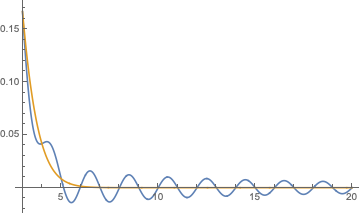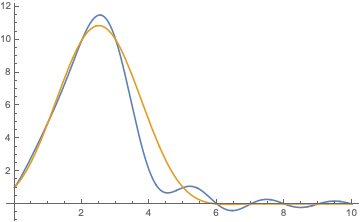Edit (1/21/21): (Start)
For your first example, a classic method of interpolation is related to fractional calculus.
$$k!\; a(k) = k! \; \oint_{|z|=r} \frac{e^z}{z^{k+1}} \; dz = e^{-1}k! \; \oint_{{|z|=r}} \frac{e^{z+1}}{z^{k+1}} \; dz $$
$$= e^{-1}k! \; \oint_{|z-1|=1} \frac{e^{z}}{(z-1)^{k+1}} \; dz =e^{-1} D^k_{z=1} e^z.$$
Interpolating using a standard fractional integroderivative, of which there are several reps,
$$\lambda! \; a(\lambda) = \; e^{-1} D_{z=1}^{\lambda} \; e^z = e^{-1} \; \sum_{n \ge 0} \frac{z^{n-\lambda}}{(n-\lambda)!}\; |_{z=1}$$
$$ = e^{-z} \; \sum_{n \ge 0} \frac{z^{n-\lambda}}{(n-\lambda)!}\; |_{z=1} = e^{-z} z^{-\lambda}\; E_{1,-\lambda}(z) \; |_{z=1},$$
where $E_{\alpha,\beta}(z)$ is the Mittag-Leffler function (general definition in Wikipedia, MathWorld; some history and applications), encountered very early on by anyone exploring fractional calculus.
This method of interpolation gives the entire function
$$ a(\lambda) = e^{-1} \; E_{1,-\lambda}(1) \frac{1}{\lambda!} = e^{-1} \; \sum_{n \ge 0} \frac{1}{(n-\lambda)!} \; \frac{1}{\lambda!}, $$
which matches the OP's first graph and extends it to any real or complex argument, giving, of course, $a(k) = 1/k!$ for $k=0,1,2, ...$.
Similarly, the fractional calculus can be applied to usefully interpolate coefficients generated by $ D_z^n \; f(z)$ to those of $D_z^{\lambda} f(z)$, with care taken with defining branch cuts and contours of integration for the complex function for the point of evaluation. The fundamental example is Euler's integral rep of the beta function as depicted below. Another is the interpolation of the associated Laguerre polynomials to the confluent hypergeometric functions and, therefore, interpolations of the associated coefficients. (See links below.)
Other productive methods of interpolation--all can be related to fractional calculus--are sketched below.
(End)
Edit 1/23/21: (Start)
The interpolation you desire is obtained by applying Ramanujan's favorite Master Formula, a.k.a. Mellin transform interpolation, as discussed below and illustrated in four other MO-Qs--Q1, Q2, Q3, and Q4. This, naturally, amounts to replacing $k$ by $s$ only outside your Cauchy integral rather than within for the reason Terry Tao notes, which is equivalent to noting the Cauchy contour integration is not equal to the Mellin transform integration.
(End)
The Mellin transform pair allows for interpolation of the coefficients of generating functions, often directly connected to sinc and/or Newton interpolation. Basically, the following is a sketch of the analytics of Ramanujan's Master Formula/Theorem, which he so profoundly and elegantly wielded.
Here $(a.)^n := a_n$ in the Taylor series $e^{a.x}$ is interpolated as $a_{-s}$ via the Mellin transform of the Taylor series $f(x) = e^{-a.x}$.
First consider the normalized Mellin transform and its inverse
$$F(s) = MT[f(x)] = \int_{0}^{\infty} f(x) \; \frac{x^{s-1}}{(s-1)!} \; dx$$
$$f(x) = MT^{-1}[F(s)] = \frac{1}{2 \pi i} \int_{\sigma - i \infty}^{\sigma + i \infty} \frac{\pi}{\sin(\pi s)} F(s) \frac{x^{-s}}{(-s)!} \; ds .$$
Then the RMT holds for a class of functions such that the simple poles of the inverse sine in the inverse Mellin transform give
$$f(x) = e^{-a.x} = \sum_{n \geq 0} \frac{(-a.x)^n}{n!} = \sum_{n=0} a_n \frac{(-x)^n}{n!} =
\sum_{n=0} F(-n) \frac{(-x)^n}{n!} \; ,$$
that is, such that we may close the complex contour to the left (e.g., in the sense of the limit of a semicircle with its radius expanding to infinity) for $0 < \sigma < 1$ and $0 < x < 1$ when $F(s)$ has no singularities/poles within the contour. This rep allows an extension of the RMT (and the Mellin transform) to cases in which poles are present in $F(s)$ and to other ranges of $x$.
Also note (see, e.g., Gelfand and Shilov's "Generalized Functions") the relation
$$D_x^{m+n+1} \; H(x) \frac{x^m}{m!} = H(x) \frac{x^{-n-1}}{(-n-1)!} = \delta^{(n)}(x),$$
reflected in the two (of several) reps of the fractional differintegro op equivalent under analytic continuation
$$\frac{x^{\alpha-\beta}}{(\alpha-\beta)!} = \frac{d^{\beta}}{dx^\beta}\frac{x^{\alpha}}{\alpha!}=\int_{0}^{x}\frac{z^{\alpha}}{\alpha!}\frac{(x-z)^{-\beta-1}}{(-\beta-1)!} dz = \frac{1}{2\pi i} \oint_{|z-x|=|x|}\frac{z^{\alpha}}{\alpha!}\frac{\beta!}{(z-x)^{\beta+1}}dz ,$$
with $H(x)$ the Heaviside step function and $\delta(x)$, the Diraac delta. (This is equivalent through binomial expansion to a sinc function/cardinal series interpolation of the binomial coefficients $\binom{s}{\alpha} = \sum_{n \geq 0} \binom{s}{n} \frac{\sin(\pi(\alpha-n))}{\pi(\alpha-n)}=\sum_{n \geq 0} \binom{s}{n} \binom{0}{\alpha-n} $, an instance also of the Chu-Vandermonde identity. The contour integral for this beta function integral is easily transformed into a bandlimited Fourier transform. See, e.g., the relation to Newton interpolation in the MSE_Q "Why is the Euler gamma function the best extension of the factorial function to the reals?" For more detail and connections, see my post "Fractional calculus and interpolation of generalized binomial coefficients." The integral reps of the confluent (see this MO-Q) and non-degenerate hypergeometric functions can be expressed effectually as this or easily related differintegral ops acting on simple functions. Years ago I found the Danish masters Niels Nielsen and Niels Norlund to be most informative on contour integrals in interpolation. There is also a connection to Riemann surfaces via Pochhammer's contour for the beta function integral.)
So, under the conditions above,
$$F(-n) = \int_{0}^{\infty} f(x) \; \frac{x^{-n-1}}{(-n-1)!} \; dx = \int_{0}^{\infty} e^{-a. x} \; \delta^{(n)}(x) \; dx = a_n,$$
and this suggests the analytic continuation and relation to umbral calculus
$$F(s) = \int_{0}^{\infty} f(x) \; \frac{x^{s-1}}{(s-1)!} \; dx = \int_{0}^{\infty} e^{-a.x} \; \frac{x^{s-1}}{(s-1)!} \; dx = (a.)^{-s} = a_{-s}.$$
The iconic guiding example is the Euler gamma function integral rep with $(a.)^n = a_n = c^n$
$$ (a.)^{-s} = a_{-s} = c^{-s} = F(s) = MT[f(x)= e^{-c\; x}] = \int_{0}^{\infty} e^{-c \; x} \; \frac{x^{s-1}}{(s-1)!} \; dx = \frac{1}{c^{s}},$$
giving the interpolation of the coefficients of the Taylor series of $e^{cx}$, i.e., $a_n = c^n$, as $a_{-s}=c^{-s}=F(s)$.
Another useful example, which vividly illustrates the relation to the Appell Sheffer sequences of umbral calculus (of which the $x^n$ with e.g.f. $e^{x}$ is the basic example), is the integral rep for (what I call) the Bernoulli function, simply related to the Hurwitz zeta function and generalizing the Bernoulli polynomials,
$$ B_{-s}(z) = (B.(z))^{-s} = \int_{0}^{\infty} e^{-B.(z)t} \; \frac{t^{s-1}}{(s-1)!} \; dt $$
$$ = \int_{0}^{\infty} \frac{-t}{e^{-t}-1} \; e^{-zt} \frac{t^{s-1}}{(s-1)!} \; dt = s \; \zeta(s+1,z)$$
where the e.g.f. for the Bernoulli polynomials with $(b.)^n = b_n$ the Bernoulli numbers is
$$e^{B.(x)t} = e^{(b.+x)t} = e^{b.t} e^{xt} = \frac{t}{e^t-1} \; e^{xt}.$$
Note that
$$B_n(z) = -n \; \zeta(1-n,z),$$
$$B_n(1) = -n \; \zeta(1-n,1) =-n \; \zeta(1-n) (Riemann) = (-1)^n B_n(0) = (-1)^n b_n.$$
Through this characterization, it is not too difficult to show that the Bernoulli function inherits all the elegant properties of a regular Appell sequence, such as $D_z \; B_{s}(z) = s \; B_{s-1}(z)$.
Hankel contour deformations, Hadamard finite part regularization of the Mellin transform guided by the inverse Mellin transform, the Mellin-Barnes contour integral, and other methods of analytic continuation can be used to extend the range of $s$ and other parameters, as have been done for the integral reps of the Euler gamma and beta functions and Riemann and other zeta functions and their generalizations. In addition, interchanging summation and integration often gives rise to useful asymptotic expansions of functions a la Borel, Heaviside, Hardy, and Poincare.
Riemann knew all this stuff. Ramanujan intuited it. Hardy formalized it. (I stumbled across it on a journey starting from the ladder ops of QM and a brief comment by my old math prof Stallybrass about the sequence $D^{m+n} H(x) \frac{x^m}{m!}$ in his integral transforms class an eon ago.)
For application to defining fractional powers of operators, see my answer and comments therein to the MO-Q "What does the inverse Mellin transform really mean?" and several of my blog posts, such as "The Creation / Raising Operators for Appell Sequences."



